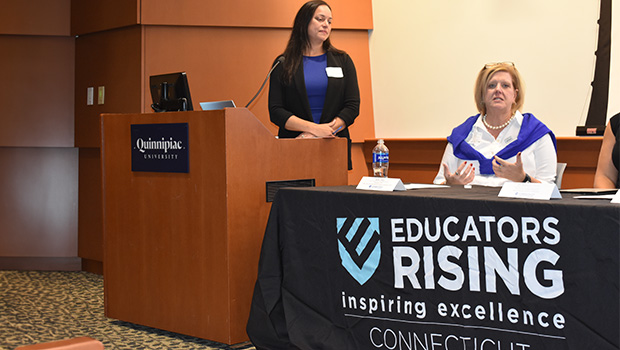Growing and diversifying Connecticut’s professional educator workforce, which has long been at the center of CEA’s legislative, policymaking, communications, and training efforts, was the subject of a daylong symposium hosted by the Connecticut State Department of Education’s Talent and Turnaround Offices this fall.
Held at Quinnipiac University, the third annual Increasing Educator Diversity Symposium featured a keynote address by Dr. Pedro Noguera, a leading scholar on issues related to race and equity in education, as well as panel discussions on teacher apprenticeship programs and other pathways to addressing the teacher shortage. Panelists comprised administrators and educators, including CEA President Kate Dias, CEA Aspiring Educators President Emma Sands, and State Representative Ron Napoli, Jr.—a veteran Waterbury teacher and CEA member.
“Coming from an organization that represents educators in more than 150 school districts statewide, I can say that drawing people into a profession constantly under attack and noted for its low pay, extended hours, and more work than you can ever get done in a day is a challenge,” said Dias in a discussion about teacher recruitment and retention.
“The negative narrative around teaching is getting harder to push back on, because it’s rooted in what the actual job has turned into. We are telling schools, ‘We expect you to be everything, but we’re not going to increase your funding for that, we’re not going to increase your training for that, and we’re not going to increase your staffing for that.’ Public education is the single greatest opportunity in front of our students, our communities, and our economy, and the failure to invest in that is consequential. The people who are drawn to education have an overwhelming desire to do the hard work it entails and to uplift students, but only with adequate funding can we make teaching the manageable, meaningful, exciting, and inviting opportunity it’s meant to be. Shifting the narrative around teaching requires resources, support, and innovation.”
Dismantling barriers
On the subject of innovation, Dias spoke to the need for greater flexibility, creativity, respect, and trust for educators in areas ranging from pedagogy to high school graduation requirements—a sentiment echoed by Sands, who touched on the need for aspiring educators to have the kind of autonomy and experience at the head of the classroom that builds skills and confidence as they prepare to enter the profession.
Asked what policies he would advance to address the teacher shortage, Napoli proposed, “making sure we pay teachers what they should be paid and looking to them for ideas on professional development that they would find meaningful and that matters.”
Noting CEA’s ongoing programs and initiatives to bring more people of color into the profession, Dias said, “It’s also critical to build out support networks that bring educators of color together, which we work hard at doing. Not only is it incredibly important as a way of enhancing the educational experience of our students, but it’s critical to avoiding the disconnectedness and isolation that comes with being the only educator of color in a school building or community. There’s an extraordinary amount of stress in that situation.”
Sands also pointed out the financial burden that keeps many excellent candidates from entering the profession.
“I worked two jobs to pay for rent, tuition, and groceries while doing a semester of basically full-time, unpaid student teaching—which is not feasible for everyone,” she recalled. “That alone is a huge barrier. Paid student teaching would go a long way toward making the profession accessible. Even our students are aware of the stigma and low pay around teaching—and unpaid student teaching just reinforces that.”
Many of the goals discussed at the symposium will shape CEA’s agenda for the 2025 legislative session, which begins January 8.







